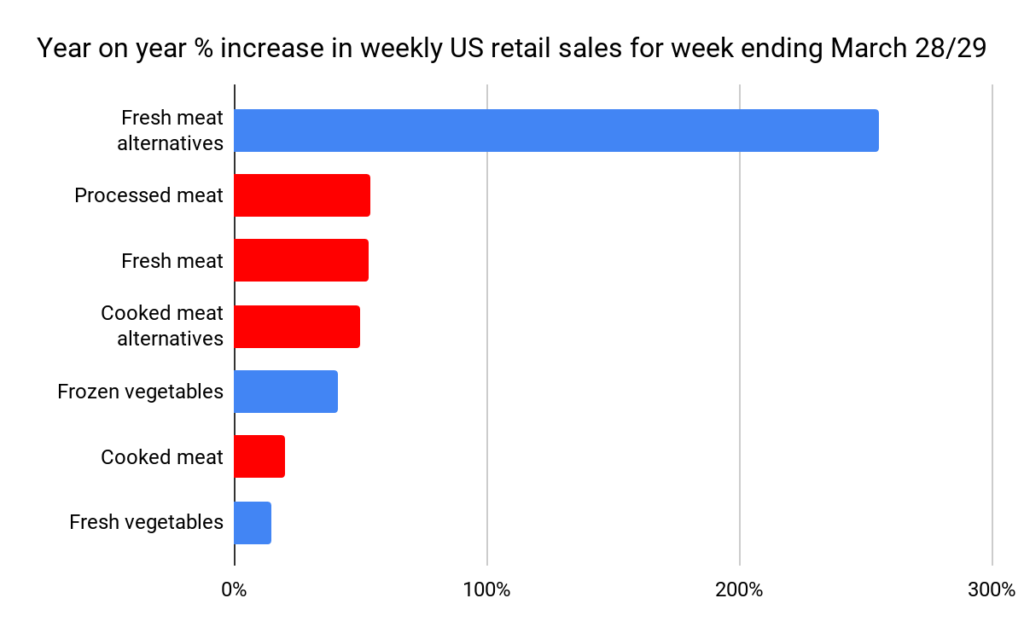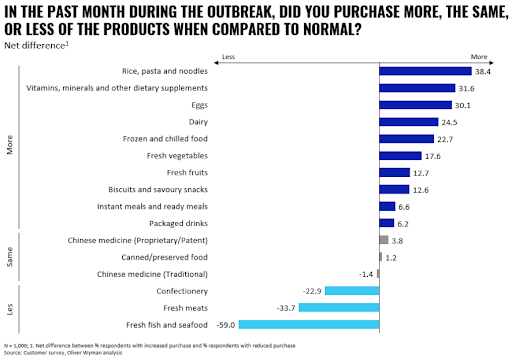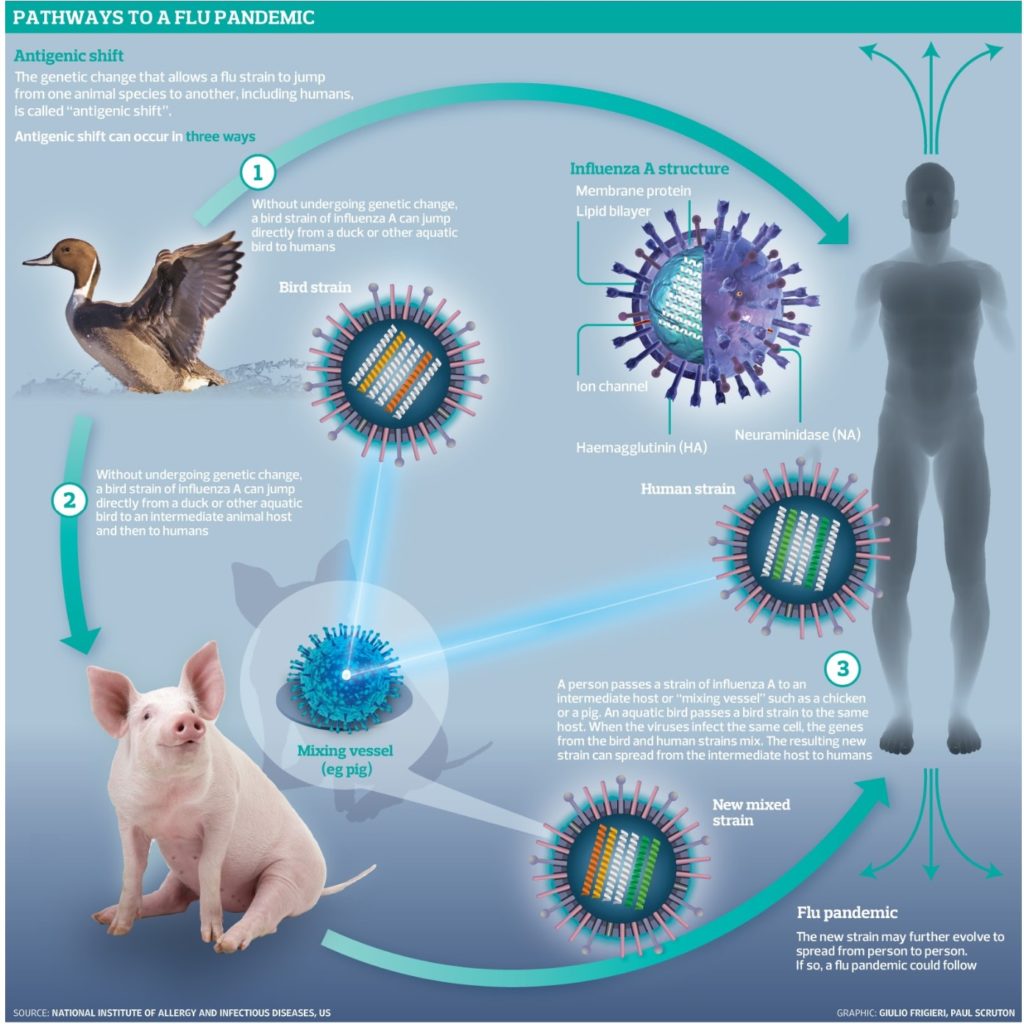This article was written by Lewis Bollard. Lewis is the farm animal welfare program officer at the Open Philanthropy Project. In that role, he researches opportunities to do the most good for farm animals.
I have shared it here because I think it’s really worth reading. It’s thorough, feels unbiased, it shares facts about COVID-19 and addresses some myths about it too.
COVID-19 and Farm Animals
I hope you and your loved ones are safe in this difficult time. As the world, including many of our colleagues at Open Philanthropy, focuses on the tragic human implications of COVID-19, here are some initial thoughts on how it may affect farm animals.
Impact on US Meat Consumption
COVID-19’s biggest impact on animals may be how it affects demand for their meat. In the US, panic buying drove fresh meat retail sales up 50-100% in late March. Even with restaurants buying less, Tyson foods reported“unprecedented” demand, while poultry giant Sanderson Farms added extra shifts at its slaughterhouses. JP Morgan upgraded its recommendation for both companies to overweight, noting that demand may endure because meat is perishable. US wholesale egg prices hit an all-time high, at triple their level in early March.
But supply disruptions may stop producers from filling this demand. Dairy farmers are dumping milk despite record demand because they can’t get it to market. And seven of the largest US chicken producers have already reported COVID-19 cases at their slaughterhouses, leading to slowdowns. At one Perdue slaughterhouse, workers walked off the job, with one saying, “We’re up here risking our life for chicken.”
Plant-based meats, meanwhile, are also selling well. Despite anecdotal reports that they were the only items left in the meat aisle, Nielsen data showed meat alternative sales growth outpacing that of conventional meat — albeit from a much lower base. (This was well above the already impressive growth in US retail plant-based meat sales, which grew 18.4% in 2019.) And while Impossible Foods’ dependence on foodservice is harming it, most plant-based meat makers sell primarily through retail, and some are scaling up to meet record demand.
A more enduring effect may be the financial crisis. In past recessions, meat production has declined: across the 2009 recession, US per capita meat consumption fell by about 10%, sparing over 500M farm animals. But in that case the recession coincided with record high grain prices, which drove chicken prices up. With grain prices now cheap, Rabobank predicts the coming recession may increase global chicken consumption, as cash-strapped consumers substitute it for more expensive red meat.

US retail sales of plant-based meats surged in late March, but so did sales of meat. Note this was the week after the biggest spike in panic buying, and looks similar to sales for all of March. Source: Meat and meat alternatives data is from Nielsen for week ending March 28, compiled from Food Navigator and New York Times; vegetable data is from IRI for week ending March 29, compiled from Produce Bluebook.
Impact on Global Meat Consumption
The global impacts have been more mixed. In China and India, poultry farmers have killed millions of birds — due to shocks to feed supply and demand — some via live burial. (This is not uncommon: Chinese pig farmers buried and burned pigs alive last year to contain African Swine Fever, while US egg farmers baked birds alive to contain avian flu in 2016.).
But supply and demand disruptions may spare more animals. In China, a rush on meat at supermarkets was followed by a drop in demand, and even in the midst of the crisis self-reported consumption of fresh meat and seafood was down (see below). In Russia, chicken producers can’t import the breeding stock they need to keep raising more chickens. And in India, false news reports linking poultry consumption to COVID-19 tanked demand for chicken.
As usual, though, the greatest number of animals will be affected by what happens underwater. For now, fish are getting a reprieve: many fishing fleets are docked, and may be for a while, since fish sales rely heavily on restaurants. And in China, which has 58% of the world’s farmed fish, demand is down. A survey of 55 major markets in Beijing, Shanghai, and Guangzhou in early March found that aquatic sales had only recovered to about half their normal levels.

At the height of the COVID outbreak, Chinese consumers reported cutting back on fresh meat and seafood purchases, while increasing purchases of grains, eggs, dairy, and fruit and vegetables, and frozen food (which included frozen meat and seafood). Source: February 2020 Oliver Wyman survey of nationally representative sample of Mainland Chinese consumers, n=1000.
Impact on Policy
Farmed wild animals have already benefited from COVID-19 policymaking. In early February, China’s Politburo committed to “resolutely ban and severely crack down on illegal wildlife markets and trade.” A few weeks later, the National People’s Congress adopted a comprehensive ban on farming, hunting, and selling wild animals for meat. And while a similar ban after the 2003 SARS outbreak was short-lived and poorly enforced, Chinese officials gave detailed plans to enforce this one. Within days, the Guardian reported that China had shut down at least 19,000 wildlife farms (which confine undomesticated animals, like frogs and squirrels).
The ban is a positive step, but incomplete. It only covers wildlife raised for “edible uses”: the larger population of wildlife farmed for fur and medicinal products are excluded. It also only covers wildlife markets, not the much larger — and equally cruel — live markets for farm animals. Shenzhen has already redefined aquatic wild animals, like frogs and turtles, as farm animals to allow their continued farming and trade. (Though five Chinese provinces have temporarily closed live poultry markets, and investment bank Jefferies speculates that Chinese authorities may close the markets in cities nationwide.)
By the way, these exceptions appear to be the source of a spate of recentheadlines claiming that China has reopened its wild animal markets. This purported action earned condemnations from Tucker Carlson, Lindsay Graham, and even Dr. Anthony Fauci — and an op-ed defending the decision in The Washington Post. But all of these reports appear to be based on one by the UK’s Daily Mail, whose correspondents documented wet markets selling farm animals and medicinal products from wild animals — which, unfortunately, were never covered by the ban.
It’s unclear whether other Asian nations will follow suit. So far only Vietnam has, but advocates from India to the Philippines are pushing for bans. There aren’t reliable statistics on live markets, but one expert estimates that “millions of animals [are] for sale on a daily basis” in markets across the region. After the 2003 SARS outbreak, the Chinese authorities reportedly confiscated over 800,000 wild animals in markets in Guangzhou alone. Billions of chickens and fish are likely traded through the live markets of India and Indonesia each year.
The policy implications for meat production are less clear. Analysts expect China to accelerate its national transition toward large-scale factory farms, which officials believe are better equipped to implement strict biosecurity measures than backyard farms. And recent EU and US stimulus packages include substantial subsidies for the fishing and meat industries. But the crisis has also drawn attention to the public health risks of animal agriculture, and analysts expect China to promote plant-based meat to diversify in the wake of the crisis.

How zoonoses jump from animals to humans. Source: National Institute of Allergy and Infectious Diseases, though I took it from Cynthia Schuck and Wladimir Alonso’s report mentioned below.
Impact on Advocacy
Meanwhile, farm animal advocacy has come to an almost complete halt, as legislatures, corporations, and even social media are focused on COVID-19. Farm advocacy groups are well-prepared for the lockdowns, since most have entirely remote workforces. But many have taken a financial hit to their reserves as the stock market plunged, and now worry the recession could harm their year-end fundraising.
Advocates are now debating how to message the connection between factory farms and pandemics. It’s easy to overstate the case: animal agriculture didn’t cause COVID-19, despite numerousclaims. And while about 3 out of 4 new or emerging infectious diseases are zoonotic, most come from wild animals: a 2008 Nature study found that 72% of new zoonotic infectious diseases tracked from 1960 to 2004 originated in wildlife. It’s also easy to create a backlash — for an exemplar, see this VeganNewsNow piece headlined “Dear Non-Vegans, It’s Your Fault.”
But there is a powerful case that factory farms are a public health nightmare. Even when zoonoses begin in wildlife, hens and pigs can be intermediate hosts who pass the virus on to humans. Indeed, there are almost always deadly viruses circulating in factory farms: right now there are multiple avian flu outbreaks in China, India, the Philippines, and the US. And some of these viruses are far deadlier than COVID-19, if also typically less virulent. H5N1, which is currently circulating in chicken farms, has a human mortality rate of 60%.
Public health researchers Cynthia Schuck and Wladimir Alonso address these risks in an excellent new report. They explain how factory farms provide a perfect breeding ground for highly pathogenic viruses: a high density of genetically uniform animals, suffering immunosuppression induced by chronic stress, living on top of their own waste without sunlight or fresh air. They also explore how factory farms’ abuse of antibiotics is hastening a post-antibiotic era, where bacteria could be as deadly as viruses.
I don’t know how to strike the right balance here. In conversations with advocates and funders over the last few weeks, I’ve found a wide range of opinions on how to balance the benefits and risks here, so I won’t claim to have the one right answer. I’m more confident in the need to support farm animal advocates in this tough time. I hope we can get through this together, and achieve a better world for farm animals on the other side.
You can find the article on Open Philanthropy.
I would love to hear from you and find out what you think of this article.


